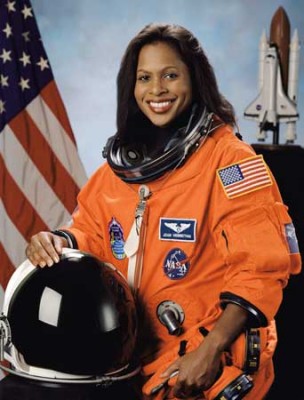Joan Higginbotham – Astronaut out of the blue
On December 9, 2006, Joan Higginbotham travelled in the space shuttle Discovery to the International Space Station. Four months later, she and her colleagues visited SKF and Gothenburg. Evolution met her for an interview.
On December 9, 2006, Joan Higginbotham travelled in the space shuttle Discovery to the International Space Station. Four months later, she and her colleagues visited SKF and Gothenburg. Evolution met her for an interview.
It is a crisp and sunny morningin Gothenburg, Sweden. Joan Higginbotham has travelled to Sweden with the crew of the space shuttle Discovery, and this particular morning she is participating in a lecture at the International Science Festival at Chalmers University in Gothenburg.
Though many of the spectators are there to see the first Swedish astronaut, Christer Fuglesang, it is Joan Higginbotham who stands out. She is small, almost petite, and with her infectious smile and meticulously neat appearance, she looks like anything but the stereotype of an astronaut.
Higginbotham says that as a little girl and later as a student, she never dreamed of going into space. Instead, she set her sights on becoming an electrical engineer, working for IBM. However, this was in 1987, and IBM wasn’t hiring engineers.
“In the interim, NASA, the US’s National Aeronautics and Space Administration, which used to interview at our campus, was looking for electrical and mechanical engineers,” Higginbotham recalls. “Unbeknownst to me, they got all our résumés and out of the blue one day a manager called me up and offered me a choice of two positions at Kennedy Space Center.”
At first, she says, she thought it was a practical joke, but the person on the other end of the line was serious.
“Basically they flew me down there,” she says. “I saw the launch pad, and it looked like something out of Star Wars, and I thought, I can do this.”
So in 1987 Higginbotham started her career at the Kennedy Space Center in Florida as a payload electrical engineer in the Electrical and Telecommunications Systems Division. She later worked on the shuttle payload bay reconfiguration for all shuttle missions and conducted electrical compatibility tests for all payloads flown aboard the shuttle. But she still didn’t think about becoming an astronaut.
“I was very content,” Higginbotham says, “and I kept on getting promotions and moving up the ladder. One day my manager suggested to me that I’d make a good astronaut.”
Eventually she applied and got selected as an astronaut candidate, and in August of 1996 she started her training.
By the timeHigginbotham took off, together with the rest of the crew of STS-116 Discovery, on Dec 9, 2006, they had been training for more than a decade.
“I really can’t describe the feeling when we took off,” she says. “I wish I could, but it is just one of those things that you absolutely have to experience yourself. It was incredible. I was sitting with Christer Fuglesang and another crewmember, and when we took off, we joined our hands and raised them in joy and euphoria.”
While in space, her main assignment was to operate the Space Station’s robotic arm. A nerve-wracking assignment, she says.
“Every time I did that I had what I call a precious cargo on the end,” Higginbotham explains. “The first time I had a truss that we were going to install on the Space Station. The second time and third time I had a crewmate on the end of the arm.”
Nerve-wracking or not, the mission went well and after 12 days, 20 hours and 45 minutes, Higginbotham’s first space mission was completed. Would she do it again?
“Absolutely,” she says. “If they tell me tomorrow that I’d be going up in five months’ time, I’d say ‘OK, let’s go.’
There are a couple of things that makes this so very special,” Higginbotham continues. “On a personal level it is quite an achievement. On a more global level, I feel that this is the way I get to contribute to my nation, by helping build this international space station. We are working with a total of 15 other countries besides the US, so we are doing our own bit in fostering global cooperation.”
Higginbotham is the third African-American woman in space, and that, she says, is also important.
“There are a lot of black children that have absolutely no role models, and the people they see on TV are the pimps and the drug dealers,” she says. “So they need something positive in their lives. From that standpoint it is really important.”
Otherwise, Higginbotham says,she finds it hard to think of herself as a role model. She says that she tries to live her life based on three principles, and if someone finds that inspiring, that’s “wonderful.”
“First of all I try to be a good person, because that is something no one can take away from you,” she says. “Secondly, I try to be a good and productive citizen. Thirdly and most importantly, I try not to embarrass my parents.”
Six years ago she lost her dad, but her mother is still alive, and though a bit nervous for most of the mission, she is extremely proud of her daughter today.
“As all mothers are,” says Higginbotham, emphasizing that she is actually just like anyone else. Her boyfriend has a construction company, her brother is an orthopaedic surgeon, and her sister is a speech
therapist.
“When I am not working I like to work out; that’s my destressor,” she says. “I hang out with my friends. We go out shopping and to dinners and catch up with each other, just normal stuff. I mean, we are quite normal people. We just have extraordinary jobs.”


